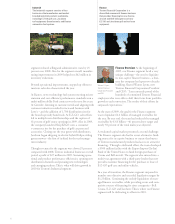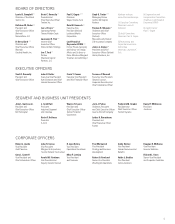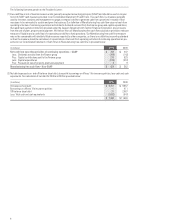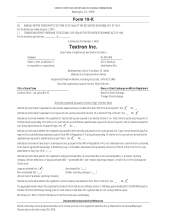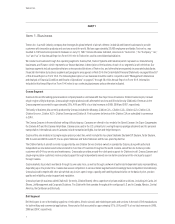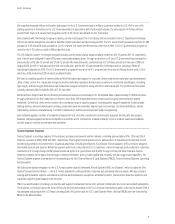E-Z-GO 2009 Annual Report Download - page 16
Download and view the complete annual report
Please find page 16 of the 2009 E-Z-GO annual report below. You can navigate through the pages in the report by either clicking on the pages listed below, or by using the keyword search tool below to find specific information within the annual report.
7
Textron Inc.
Item 1A. Risk Factors
Our business, financial condition and results of operations are subject to various risks, including those discussed below, which may affect the
value of our securities. The risks discussed below are those that we believe currently are the most significant, although additional risks not
presently known to us or that we currently deem less significant also may impact our business, financial condition or results of operations,
perhaps materially.
Decline in demand for our aircraft products, cancellation of orders and delays in aircraft delivery schedules may continue to
adversely affect our financial results.
The current weak economic environment has resulted in significantly reduced demand for our aircraft and a tightening of credit availability for
potential purchasers of our aircraft, as well as a substantial number of cancellations of orders and customer requests for delayed delivery of
ordered aircraft. Weak economic conditions may continue to soften demand for new and used business jets and helicopters and may continue to
adversely impact the pricing of new aircraft and the valuation of used aircraft. Difficult conditions in the financial markets may continue to
adversely impact our customers’ ability to fund or finance purchases of our aircraft. Weakness in the economy may continue to result in fewer
hours flown on existing aircraft and, consequently, lower demand for spare parts and maintenance. We generally make sales of our commercial
aircraft under purchase orders that are subject to cancellation, modification or rescheduling. Aircraft customers, including sellers of fractional
share interests, may continue to respond to weak economic conditions by canceling orders and/or delaying delivery of orders. In addition, both
U.S. and foreign governments and government agencies regulate the aviation industry; they may impose new regulations with additional aircraft
security or other requirements or restrictions, including, for example, environmental-related restrictions and/or fees, that may adversely impact
demand for business jets and/or helicopters. Moreover, a prolonged downturn in our markets may impact our decision to invest in the
development of new products or improvements to existing products, which could adversely impact our future competitiveness and profitability.
Reduced demand for new and used aircraft, spare parts and maintenance, continued cancellations of orders and/or delivery delays could
significantly reduce our revenues, profitability and cash flows.
We may not be able to continue to execute the liquidation of our Finance segment’s non-captive commercial finance business
at a favorable pace and level of recovery.
In the fourth quarter of 2008, we announced a plan to exit the non-captive portion of the commercial finance business of our Finance segment,
while retaining the captive portion of the business that supports customer purchases of products that we manufacture. The exit plan is being
effected through a combination of orderly liquidation and selected sales. We cannot be certain that we will be able to continue to accomplish the
orderly liquidation of our portfolio on a timely or successful basis or in a manner that will generate cash sufficient to service our Finance
segment’s debt. We may encounter delays and difficulties in effecting the continued orderly liquidation of our various receivable portfolios as a
result of many factors, including the inability of our customers to find alternative financing, which could expose us to increased credit losses. We
may have greater difficulty in selling the remaining receivables that have been designated for sale or transfer, assets that have been acquired upon
foreclosure of receivables and/or other non-operating assets at the pricing that we anticipate or in the time frame that we anticipate. We may be
required to make additional mark-to-market or other adjustments against assets that we intend to sell or to take additional reserves against assets
that we intend to retain. We may change our current strategy based on either our performance and liquidity position or changes in external factors
affecting the value and/or marketability of our assets, which could result in changes in the classification of assets we intend to hold for investment
and additional mark-to-market adjustments. We may incur higher costs than anticipated as a result of this exit plan or be subject to claims made
by third parties, and the exit plan may result in increased credit losses. We expect that our portfolio quality will continue to deteriorate as we
proceed through the liquidation and the mix of assets changes and that our cash conversion ratio on liquidation will decrease; this deterioration
could be more severe and the cash conversion ratio lower than we anticipate, resulting in substantial credit losses. Significant delay or difficulty
in executing the continued liquidation and/or substantial losses could result in the failure of our portfolio to generate the cash necessary to
service our Finance segment’s indebtedness, resulting in continuing or increased adverse effects on our financial condition and results of operations.
Difficult conditions in the financial markets have adversely affected the business and results of operations of our Finance
segment, and we do not expect these conditions to improve in the near future.
The financial performance of our Finance segment depends on the quality of loans, leases and other credit products in its finance asset portfolios.
Portfolio quality may be adversely affected by several factors, including finance receivable underwriting procedures, collateral quality, or
geographic or industry concentrations, as well as the ability of our customers to obtain alternative financing as our Finance segment exits certain
lines of business. Financial market conditions over the previous 18 months have resulted in significant writedowns of asset values by financial
institutions, including government-sponsored entities and major commercial and investment banks. These writedowns, initially of mortgage-
backed securities but spreading to credit default swaps and other derivative securities, have caused many financial institutions to seek additional


